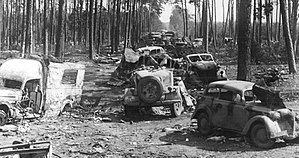
Back معركة هالب Arabic Slaget ved Halbe Danish Kesselschlacht von Halbe German Batalo de Halbe Esperanto Batalla de Halbe Spanish Halben taistelu Finnish Bataille de Halbe French Pertempuran Halbe ID Battaglia di Halbe Italian ハルベの戦い Japanese
This article needs additional citations for verification. (May 2024) |
| Battle of Halbe | |||||||
|---|---|---|---|---|---|---|---|
| Part of Battle of Berlin | |||||||
 A destroyed Wehrmacht convoy near Spree Forest, April 1945 | |||||||
| |||||||
| Belligerents | |||||||
|
|
| ||||||
| Commanders and leaders | |||||||
|
Theodor Busse Walther Wenck Matthias Kleinheisterkamp † |
Georgy Zhukov Ivan Konev | ||||||
| Strength | |||||||
|
About 80,000 in the Halbe Pocket
| 280,000 | ||||||
| Casualties and losses | |||||||
|
30,000 killed 25,000 escaped 10,000 civilians killed[1] | 20,000 killed or missing[1] | ||||||
Location within Germany | |||||||
The Battle of Halbe (German: Kesselschlacht von Halbe, Battle of the Halbe Pocket; Russian: Хальбский котёл, Halbe pocket) was a battle lasting from April 24 – May 1, 1945[2] in which the German Ninth Army—under the command of General Theodor Busse—was destroyed as a fighting force by the Red Army during the Battle of Berlin.
The Ninth Army, encircled in a large pocket in the Spree Forest region south-east of Berlin, attempted to break out westwards through the village of Halbe and the pine forests south of Berlin to link up with the German Twelfth Army commanded by General Walther Wenck with the intention of heading west and surrendering to the Western Allies. To do this, the Ninth Army had to fight its way through three lines of Soviet troops of the 1st Ukrainian Front under the command of Marshal Ivan Konev, while at the same time units of the 1st Belorussian Front, under the command of Marshal Georgy Zhukov, attacked the German rearguard from the northeast.
After heavy fighting, about 30,000 German soldiers—just over one third of those originally in the pocket—reached the comparative safety of the Twelfth Army's front lines. The rest were either killed or captured by Soviet forces.[citation needed]
- ^ a b Beevor, Athony (2003). Berlin: Slutstriden 1945 [Berlin: The Downfall 1945] (in Swedish). Translated by Gyllenhak, Ulf (3rd ed.). Lund: Svenska Historiska Media Förlag AB. p. 382. ISBN 91-85057-01-0.
- ^ Le Tissier 2005, p. 206.
